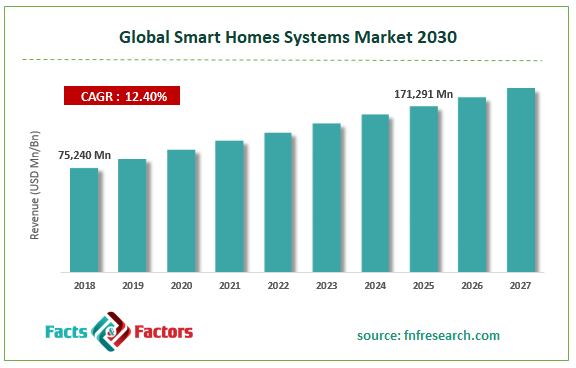Search Market Research Report
Smart Homes Systems Market Size, Share Global Analysis Report, 2018 – 2025

Smart Homes Systems Market By Product (Lighting Control, Home Appliances, Security & Access Control, Entertainment & Other Controls, HVAC Control, and Others): Global Industry Perspective, Comprehensive Analysis, and Forecast 2018 – 2025
Industry Insights
[190+ Pages Report] According to the report published by Facts and Factors, the global Smart Homes Systems market was valued at approximately USD 75,240 million in 2018 and is expected to reach a value of around USD 171,291 million by 2025, at a CAGR of around 12.4% between 2019 and 2025. The report covers the forecast and analysis of the Smart Homes Systems market on a global and regional level. The study provides historical data from 2015 to 2018 along with a forecast from 2019 to 2025 based on revenue (USD Million). The study includes drivers and restraints of the Smart Homes Systems market along with the impact they have on the demand over the forecast period. Additionally, the report includes the study of opportunities available in the Smart Homes Systems market on a global level.

In order to give the users of this report a comprehensive view of the Smart Homes Systems market, we have included a competitive landscape and an analysis of Porter’s Five Forces model for the market. The study encompasses a market attractiveness analysis, wherein all the segments are benchmarked based on their market size, growth rate, and general attractiveness.
The report provides company market share analysis to give a broader overview of the key players in the market. In addition, the report also covers key strategic developments of the market including acquisitions & mergers, new service launches, agreements, partnerships, collaborations & joint ventures, research & development, and regional expansion of major participants involved in the market on a global and regional basis.
The study provides a decisive view of the Smart Homes Systems market by segmenting the market based on product and regions. All the segments have been analyzed based on present and future trends and the market is estimated from 2019 to 2025.
The growing significance of monitoring of home activities through remote sites along with an increase in the requirement for power-saving & low carbon-emitting solutions will steer the business growth over the forecast period. Apparently, an increase in the use of smartphones and smart gadgets coupled with growing safety concerns will drive the market expansion over the timespan from 2019 to 2025. Governments across the globe are encouraging the use of home automation systems and this will further succor the industry growth over 2019-2025. However, restricted transmission between the electronic equipment and low awareness about the benefits of using smart homes systems will inhibit the expansion of the market over the forecast timeframe. Apart from this, huge costs of platform integration can further hamper the market growth over the period from 2019 to 2025.
 Report Scope
Report Scope
Report Attribute |
Details |
Market Size in 2018 |
USD 75,240 Million |
Projected Market Size in 2025 |
USD 171,291 Million |
CAGR Growth Rate |
12.4% |
Base Year |
2018 |
Forecast Years |
2019-2025 |
Key Market Players |
Alarm.com, Amazon.com, Inc., Chiyu Technology Co., Ltd., Control4, Crestron Electronics, Google LLC, Leviton Manufacturing Company, Inc., Logitech International S.A., Mantra Softech Pvt. Ltd., Orient Electric Limited, Honeywell International, Johnson Controls International plc, Samsung, Schneider Electric SE, Siemens, and Robert Bosch GmbH. |
Key Segment |
by Product, and By Region |
Major Regions Covered |
North America, Europe, Asia Pacific, Latin America, and the Middle East & Africa |
Purchase Options |
Request customized purchase options to meet your research needs. Explore purchase options |
Based on the product, the market divided into Lighting Control, Home Appliances, Security & Access Control, Entertainment & Other Controls, HVAC Control, and Others.
 Competitive Landscape:
Competitive Landscape:
Some of the key players in the market include
- Alarm.com
- Amazon.com Inc.
- Chiyu Technology Co. Ltd.
- Control4
- Crestron Electronics
- Google LLC
- Leviton Manufacturing Company Inc.
- Logitech International S.A.
- Mantra Softech Pvt. Ltd.
- Orient Electric Limited
- Honeywell International
- Johnson Controls International plc
- Samsung
- Schneider Electric SE
- Siemens
- Robert Bosch GmbH.
This report segments the Smart Homes Systems market as follows:
 By Product Segment Analysis
By Product Segment Analysis
- Lighting Control
- Home Appliances
- Security & Access Control
- Entertainment & Other Controls
- HVAC Control
- Others
 Smart Homes System Market: Regional Segment Analysis
Smart Homes System Market: Regional Segment Analysis
- India
- Australia
- Canada
- ROW
Industry Major Market Players
- Alarm.com
- Amazon.com Inc.
- Chiyu Technology Co. Ltd.
- Control4
- Crestron Electronics
- Google LLC
- Leviton Manufacturing Company Inc.
- Logitech International S.A.
- Mantra Softech Pvt. Ltd.
- Orient Electric Limited
- Honeywell International
- Johnson Controls International Plc
- Samsung
- Schneider Electric SE
- Siemens
- Robert Bosch GmbH
Frequently Asked Questions

Copyright © 2024 - 2025, All Rights Reserved, Facts and Factors


